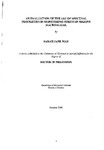AN EVALUATION OF THE USE OF SPECTRAL PROPERTIES IN MONITORING STRESS IN MARINE MACROALGAE
| dc.contributor.author | MAY, SARAH JANE | |
| dc.contributor.other | School of Biological and Marine Sciences | en_US |
| dc.date.accessioned | 2013-11-14T10:03:07Z | |
| dc.date.available | 2013-11-14T10:03:07Z | |
| dc.date.issued | 2000 | |
| dc.identifier | NOT AVAILABLE | en_US |
| dc.identifier.uri | http://hdl.handle.net/10026.1/2706 | |
| dc.description | Merged with duplicate record 10026.1/603 on 28.02.2017 by CS (TIS) | |
| dc.description.abstract |
The overall aim of this thesis was to assess the potential of developing specific quantifiable assays of pollutant damage based on changes on the in vivo optical properties of macroalgae, applicable to laboratory and remote systems. The green macroalgae, E.intestinalis, was exposed to selected trace metals (copper and zinc), triazine herbicides (Irgarol 1051 and atrazine) and a series of alcohols (n = 1 - 9). The algal in vivo spectral properties, measured using a spectrophotometer fitted with an integrating sphere, determined changes due to exposure, and results were compared with established methods, including growth and fluorescence, to assess algal health status. Each pollutant, except zinc, had a significant (P < 0.05) effect on in vivo spectral properties at the range of concentrations used. The results indicated that the technique has potential to identify the algal systems affected by the pollutant, as signatures obtained appeared to indicate whether change was due to structure or pigments. The technique was sensitive, repeatable, and could detect individual pollutants in a copper/Irgarol 1051 mixture. The results were mathematically interpreted to provide ratios, individual wavelengths, sensitivity figures, web diagrams and QSARs to highligh.t differences between pollutant effect. The QSAR, obtained from E.intestinalis exposed to a series of alcohols, had a R2 value of0.9682 using in vivo absorptance at 680 nm and Log Kow, which corresponds with published values of 0.97 using ion leakage with the same species. However, the technique of in vivo spectral properties has the advantage of being non-invasive. Samples of E.intestinalis were collected from different field sites and their in vivo spectral responses could be grouped according to potential pollutants to which they had been exposed. In addition, the potential of extending the technique for use in remote sensing is discussed. It was concluded that the technique of monitoring in vivo spectral properties is an appropriate biomonitor to add to the expanding range of current biomonitors. | en_US |
| dc.language.iso | en | en_US |
| dc.publisher | University of Plymouth | en_US |
| dc.title | AN EVALUATION OF THE USE OF SPECTRAL PROPERTIES IN MONITORING STRESS IN MARINE MACROALGAE | en_US |
| dc.type | Thesis | |
| plymouth.version | Full version | en_US |
| dc.identifier.doi | http://dx.doi.org/10.24382/3805 | |
| dc.identifier.doi | http://dx.doi.org/10.24382/3805 |
Files in this item
This item appears in the following Collection(s)
-
01 Research Theses Main Collection
Research Theses Main


